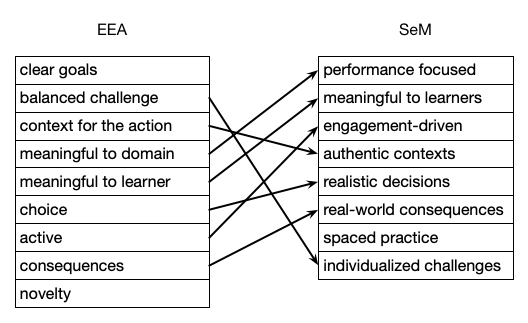Engaging Learning and the Serious eLearning Manifesto
Author: Clark
Go to Source
Way back in ’05, my book on games for learning was published. At its core was an alignment between what made an effective education practice and what makes engaging experiences. There were nine elements that characterized why learning should be ‘hard fun’. More recently, we released the Serious eLearning Manifesto. Here we had eight values that differentiated between ordinary elearning and serious elearning. So, the open question is how do these two lists match up? What is the alignment between Engaging Learning and the Serious eLearning manifesto?
The elements of the Serious eLearning Manifesto (SeM) are pretty straightforward. They’re listed as:
- performance focused
- meaningful to learners
- engagement driven
- authentic contexts
- realistic decisions
- real-world consequences
- spaced practice
- individualized challenges
The alignment (EEA: Effectiveness-Engagement Alignment) I found in Engaging Learning was based upon research I did on designing games for learning. I found elements that were repeated across proposals for effective education practice, and ones that were stipulated for engaging experiences. And I found a perfect overlap. Looking for a resolution between the two lists of elements looks something like:
- clear goals
- balanced challenge
- context for the action
- meaningful to domain
- meaningful to learner
- choice
- active
- consequences
- novelty
 And, with a little wordsmithing, I think we find a pretty good overlap! Obviously, not perfect, because they have different goals, but the important elements of a compelling learning experience emerge.
And, with a little wordsmithing, I think we find a pretty good overlap! Obviously, not perfect, because they have different goals, but the important elements of a compelling learning experience emerge.
I could fiddle and suggest that clear goals are aligned to a performance focus, but instead that’s coming from making their learning be meaningful to the domain. I suggest that what really matters to organizations will be the ability to do, not know. So, really, the goals are implicit in the SeM; you shouldn’t be designing learning unless you have some learning goals!
Then, the balanced challenge is similar to the individualized challenge from the SeM. And context maps directly as well. As do consequences. And meaningfulness to learners. All these directly correspond.
Going a little further, I suggest that having choice (or appearance thereof) is important for realistic decisions. There should be alternatives that represent misconceptions about how to act. And, I suggest that the active focus is part of being engaging. Though, so too could novelty be. I’m not looking at multiple mappings but they would make sense as several things would combine to make a performance focus, as well as realistic decisions.
Other than that, on the EEA side the notion of novelty is more for engaging experiences than necessarily specific to serious elearning. On the SeM side, spaced practice is unique to learning. The notion of a game implies the ability for successful practice, so it’s implicit.
My short take, through this exercise, is to feel confident in both recommendations. We’re talking learning experience design here, and having the learning combine engagement as well is a nice outcome. I note that I’ll be running a Learning Experience Design workshop at DevLearn in October in Las Vegas, where’ll we’ll put these ideas to work. Hope to see you there!
The post Engaging Learning and the Serious eLearning Manifesto appeared first on Learnlets.
